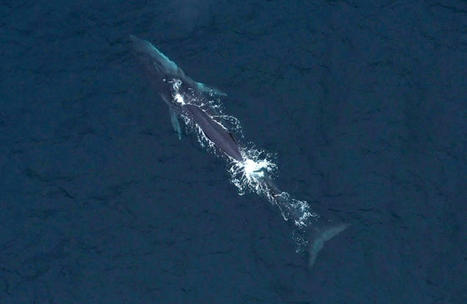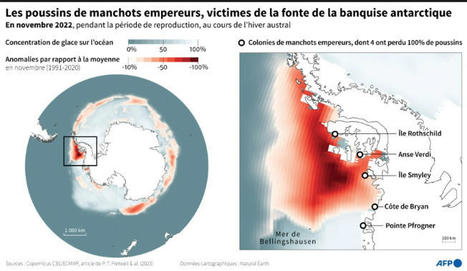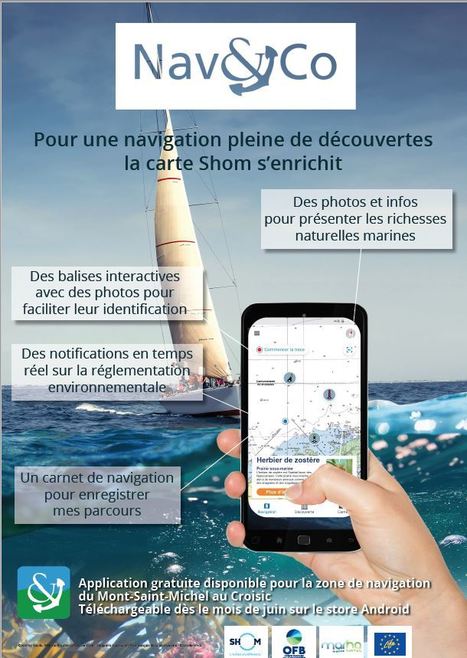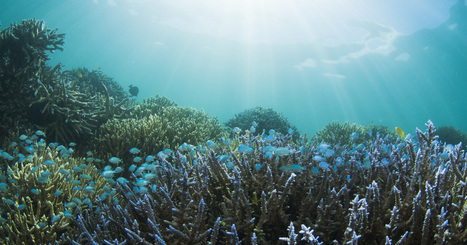 Your new post is loading...
 Your new post is loading...

|
Scooped by
DocBiodiv
|
Understanding the relative effectiveness and enabling conditions of different area-based management tools is essential for supporting efforts that achieve positive biodiversity outcomes as area-based conservation coverage increases to meet newly set international targets. We used data from a coastal social–ecological monitoring program in 6 Indo-Pacific countries to analyze whether social, ecological, and economic objectives and specific management rules (temporal closures, fishing gear-specific, species-specific restrictions) were associated with coral reef fish biomass above sustainable yield levels across different types of area-based management tools (i.e., comparing those designated as marine protected areas [MPAs] with other types of area-based management).

|
Scooped by
DocBiodiv
|
Le texte qui doit être adopté à l'ONU prévoit la création d'aires marines protégées dans les eaux internationales, dans des zones à caractère unique Comment protéger des aires marines à mille lieues des côtes? Où verront-elles le jour et quand?

|
Scooped by
DocBiodiv
|
It is intended that the legislation will provide for the identification, designation, regulation, management, enforcement and review of MPAs, ensuring that they form a coherent, connected, representative and climate-resilient network.

|
Scooped by
DocBiodiv
|
Pour se repérer dans les diverses sortes d'aires marines protégées (AMP) – dotées d'objectifs et réglementations différentes – 43 spécialistes des sciences marines et sociales, du Centre national de la recherche scientifique (CNRS) et de l'Institut de recherche pour le développement (IRD) en France, ont élaboré un guide des AMP. Publié jeudi 9 septembre dans Science, ce dernier fournit un cadre pour planifier, cartographier, suivre et contrôler l'atteinte des objectifs assignés.

|
Scooped by
DocBiodiv
|
A healthy Ocean is critical for achieving sustainable development goals but the Ocean is threatened by multiple stressors. There is a global call to increase the coverage of marine protected areas (MPAs) from 10% to at least 30% by 2030. France, a major actor for marine conservation with the second largest exclusive economic zone (EEZ) in the world, with territories in all Ocean basins but the Arctic, aims at reaching the 30% by 2022, for which one third shall include a strong protection status. However, the strategy to reach this twofold target faces two challenges. First, while some standards exist to classify the levels of protection, France is currently using a case specific, loose approach to define strong protection. Second, there is no criteria that addresses the representativeness of the protection across French Ocean basins. Here, we assess the protection levels of the 524 French MPAs and their distribution across territories and habitats. While 33.7% of France’s waters are covered by an MPA, 12.5% of these areas do not impose regulations stronger inside than outside. Full and high levels of protection, the most effective for biodiversity conservation, represent only 1.6% of French waters and are unevenly distributed across Ocean basins and habitats, with 80.5% concentrated in a single territory.

|
Scooped by
DocBiodiv
|
By Colin Breen and Crystal Safadi Over the past two decades, Marine Protected Areas (MPAs) have emerged as one of the primary legislative initiatives used to protect the marine environment. Additionally, they are recognised as being an integral management mechanism used to address Climate Change, and can be a driver …

|
Scooped by
DocBiodiv
|
new agreement is being negotiated under the 1982 United Nations Convention on the Law of the Sea (UNCLOS) to provide legally binding mechanisms to protect the marine environment and to conserve and ensure the sustainable use of marine biodiversity on the high seas (international waters in areas beyond national jurisdiction) (1). One of the suggested objectives in the current draft text is to “apply an approach that builds ecosystem resilience to the adverse effects of climate change” when applying area-based management tools (ABMTs), including marine protected areas (MPAs).

|
Scooped by
DocBiodiv
|
PAPEETE, le 9 septembre 2019 - Une étude du Criobe montre que les cinq aires marines totalement protégées de Moorea ont eu un impact positif sur l'environnement, dix ans après leur mise en place. Bien plus que les trois aires marines partiellement protégées de l'île-sœur.

|
Scooped by
DocBiodiv
|
La troisième session de la conférence intergouvernementale pour la négociation d’un traité sur la conservation et l’utilisation durable de la biodiversité marine des zones situées au-delà de la juridiction nationale (dite négociation BBNJ) s’est achevée le 30 août 2019 à New York. Cette session a constitué une étape importante dans l’élaboration du traité en permettant un premier travail de négociation sur un projet de texte élaboré et détaillé. Le futur traité devrait permettre la création de nouveaux outils de protection de la biodiversité marine, en particulier par la création d’aires marines protégées en haute mer...

|
Scooped by
DocBiodiv
|
Les zones de conservation halieutiques constituent officiellement une nouvelle catégorie d’aires marines protégées (AMP) suite à la parution le 19 avril dernier de leur décret de création signé par les ministères de l’Environnement, de la Pêche et des Outre-mer. Ces AMP ont pour objectif de préserver à long terme les espèces exploitées (poissons et coquillages principalement) et de bénéficier à terme aux pêcheurs qui les exploitent.
|
La Commission pour la conservation de la faune et la flore marines de l'Antarctique, qui regroupe 26 pays et l'UE, a échoué à trouver un accord pour instaurer de nouvelles aires marines protégées, malgré la fonte accélérée des glaces autour du pôle Sud, ont annoncé vendredi des ONG de défense de l'environnement.
Via Hubert MESSMER

|
Scooped by
DocBiodiv
|
En mode « Navigation », vous aurez accès à la réglementation maritime en vigueur, sans exhaustivité, ainsi qu’aux informations de balisage qui concernent l’environnement proche. Vous bénéficierez ainsi d’un appui en temps réel par le biais d’alertes. Nav&Co propose également un mode « Découverte » afin de découvrir les secrets du patrimoine naturel des alentours. Plus de 2 000 points d’intérêt sont référencés en mer et sur les côtes métropolitaines, corses et guadeloupéennes, grâce au concours des aires marines protégées.

|
Scooped by
DocBiodiv
|
Contracting Parties of the Convention for the Protection of the Marine Environment of the North-East Atlantic (the ‘OSPAR Convention’) have agreed to establish an effective network of marine protected areas (MPAs). While the network is currently covering approximately 7% of the North-East Atlantic, the extent to which existing MPAs appropriately harbour protection remains unknown. Using the regulation-based classification system, we assessed the levels of protection of 946 zones belonging to 476 strictly marine OSPAR MPAs. We show that only 0.03% of the OSPAR MPA network is covered with full or high protection levels...

|
Scooped by
DocBiodiv
|
Emmanuel Macron a décidé de classer, d'ici 2022, 30 % du territoire français, en métropole et en outre-mer, au sein « d'aires protégées », que l’Union internationale pour la conservation de la nature (UICN) définit comme « des espaces géographiques clairement définis, reconnus, consacrés et gérés, par tout moyen efficace, juridique ou autre, afin d'assurer à long terme la conservation de la nature ainsi que les services écosystémiques et les valeurs culturelles qui lui sont associés ».
Timide, diront certains, l’objectif est à portée puisque 29,5 % d’aires terrestres et 23,5 % d’aires marines sont déjà protégées dans le pays. « L’extension du réseau d’aires protégées s’appuiera sur la diversité des outils de protection français (parcs naturels régionaux, réseau Natura 2000, réserves naturelles, etc.), que ce soit en métropole ou en outre-mer et autant sur le domaine terrestre que maritime ».

|
Scooped by
DocBiodiv
|
In the face of intense human pressure on European seas, a network of well-managed marine protected areas (MPAs) is critical for marine biodiversity protection. In 2018, the EU (including, at the time, the United Kingdom) declared having met international targets for marine conservation, by designating more than 10% of its waters as MPAs. However, this declaration of success ignored the fact that designation is just one step towards achieving real protection. Without effective management, designated MPAs remain mere ‘paper parks’ that provide little to no actual protection.

|
Scooped by
DocBiodiv
|
En évaluant les 1062 aires marines protégées de la mer Méditerranée, recouvrant 6% du bassin méditerranéen, une équipe de recherche dirigée par le CNRS a montré que 95% de la surface de ces aires est dépourvue de réglementations suffisantes permettant de réduire les impacts humains sur la biodiversité

|
Scooped by
DocBiodiv
|
Sarah Dudas is in a race against time. Before the high tide returns, she and her fellow researchers are determined to survey the marine life clinging to the intertidal zone of Goose Island—a small island off the remote central coast of British Columbia.

|
Scooped by
DocBiodiv
|
The International Union for the Conservation of Nature, a global environmental organization, lists approximately 1,200 marine species worldwide that are considered vulnerable, threatened, or at-risk of extinction. Many are provided legal protection through national laws requiring research and management measures aimed at recovering and maintaining the species at a sustainable population level. Integral to the policy decision process involving the management and recovery of marine species is the consideration of trade-offs between the economic and ecological costs and benefits of protection. This suggests that economics, at its core the study of trade-offs, has a significant role. In the U.S. a somewhat traditional use of economics in protected species research and management has involved cost minimization or cost-effectiveness analyses to help select or prioritize conservation actions.

|
Scooped by
DocBiodiv
|
Le nombre d'aires marines protégées augmente constamment depuis la Convention sur la diversité biologique. Mais celles-ci sont souvent des zones partiellement protégées, dont l'efficacité pose question.
|
 Your new post is loading...
Your new post is loading...
 Your new post is loading...
Your new post is loading...



























via @Georgina_Gurney @MarineCons
Ban, N. C., Darling, E. S., Gurney, G. G., Friedman, W., Jupiter, S. D., & al. (2023) Conservation Biology, 00, e14156. https://doi.org/10.1111/cobi.14156